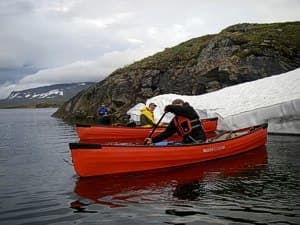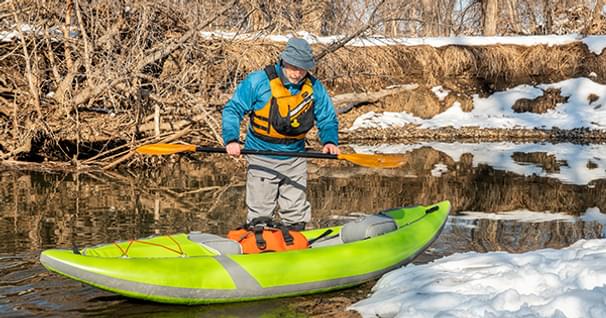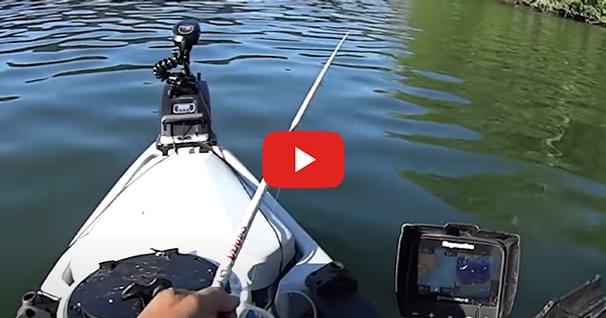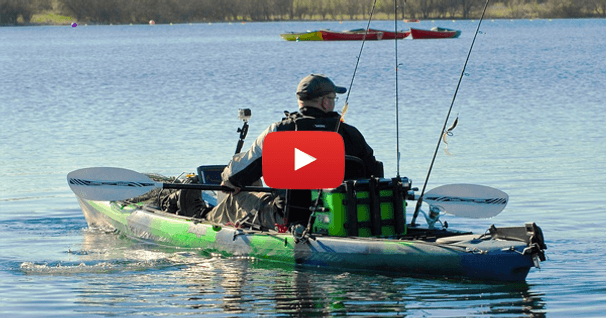Canoeing In Winter
At the outset, I should make it clear that when winter comes to my northern Wisconsin home, I don't go canoeing! Not that I haven't tried, you understand. It was February when I finished building the wood-strip prototype of Mad River's popular "Slipper," and I couldn't wait till spring to try it. A patch of blue in a nearby pond suggested there might be space enough to pirouette a new boat.

A balmy 15 degree temperature suggested perfect paddling conditions. Dressed in warm woolens, I felt smugly comfortable. No matter that my paddling hole--kept open by an air bubbler--was barely large enough for my boat, or that water droplets froze on the gunnels when I switched paddle sides. I was canoeing. In winter. In Viking land!
Then, I saw the ice chunk which a gentle breeze was pushing my way. To the left was a jagged icy shore; to the right, a bathtub-size block of ice drifting my way. I tried to push the ice chunk out of the way with the tip of my paddle. It didn't move. I did!
Seconds later, I was neck deep and hyperventilating in icy water. Fifty feet to shore seemed an impossible distance to swim, even with a life jacket on. Right then, I learned that the most important lesson in winter canoeing is, don't tip over! To this, add good judgment, the right equipment, and a friend to bail you out if you capsize, and you'll be fine.
~Get the BWCAW Tee~
With over 1,090,000 acres of wilderness area, the BWCAW is a paddler's paradise.
WHAT TO WEAR?
Closest I get to winter paddling here in Viking land is a late October solo canoe trip in the Boundary Waters Canoe Area with friends. Here, the daily high can be just above freezing, while night time temps often plunge into the teens. The rocky portaging/camping nature of the BWCA suggests a traditional (wool, fleece, nylon) approach to clothing. Scuba gear and dry suits would be too uncomfortable to wear all day, especially where frequent portages are the rule. And neoprene clothes would freeze solid when it freezes at night.
Footwear: I rely on Chota Nunavut mukluks for cold weather trips that include portaging and wading. These lightweight neoprene boots are flexible and warm, and they stick to wet rocks reasonably well.
If you paddle solo, you'll appreciate a two piece fabric splash cover for your canoe. Without one, icy water will drip into the boat (and freeze there !) whenever you change paddle sides. A cover will also cut wind resistance by half and keep you toasty warm in blowing rain and snow. I can't say enough good things about my canoe cover!
For tandem canoes, a three piece splash cover with a removable belly section is the best choice. You can make one in a weekend using plans from my book, "Expedition Canoeing", or buy a fitted model from Cooke Custom Sewing (www.cookecustomsewing.com) in Lino Lakes, Minnesota. CCS uses a non-shrink Mylar template for a perfect fit on any boat.
A change of clothes is enough for day trips. Over-nighters require the ability to dry wet things, which isn't easy in frigid weather. For this reason, I always carry full bore fire-making equipment--a knife, folding saw, hand-axe, chemical fire-starters, candle and a gasoline stove. A nylon rain tarp, outfitted with extra ties on the face and edges allows you to cook and work in sleazy weather.
Amenities: A closed-cell foam seat pad makes a convenient duff warmer in the canoe and camp. Knee-pads take the sting out of cold water paddling; you can easily make them from a closed cell foam sleeping pad. Cut the foam to shape and glue it into the hull with Weldwood, waterproof contact cement.
Everything must be protected against rain (snow!) and a capsize. Commercial dry bags or this simple system will keep things dry:
Procedure: Pack the item into a nylon stuff-sack sack which need not be waterproof. Place this sack inside a plastic bag. Tightly twist the mouth of the plastic bag, fold it over and seal it with a loop of shock-cord. Then, nest it inside another stuff-sack. Note that the delicate plastic liner (the waterproof layer) is protected on both sides by tough nylon. Apply this "sandwich" principal to everything you want to keep dry.
Some Final Thoughts:
- Bring a sponge to clean up icy paddle drips and accumulated water.
- Nights are longer in winter than in summer, so power your head-lamp with long-lasting lithium batteries.
- A glass or stainless steel vacuum bottle provides hot coffee, tea or soup as you paddle.
- A telescoping candle lantern raises tent temperatures about ten degrees.
- A wide-brimmed, waterproof hat is better than a hood that blows around in wind. Get it large enough go over a wool stocking cap.
JUDGEMENT
Capsize on a farm pond when air and water temperatures are both below 40 degrees, and you'll understand the need for caution. So unless you're wearing a dry suit, you'd best confine your winter travels to easy waters in the company of friends.
It takes time to develop the proper respect for a waterway on which help is not available. And in winter, almost every lake and river qualifies. Don't rush the learning curve. Fear is nature's way of telling you to slow down and think before you act. Icy undercut banks, floating ice chunks, a combined air/water temperature of less than 100--all spell trouble even when you're well prepared. Start out easy, equip right, surround yourself with caring friends, and you'll have a great time.
Cliff Jacobson is a professional canoe guide and outfitter for the Science Museum of Minnesota, a wilderness canoeing consultant, and the author of more than a dozen top-selling books on camping and canoeing. www.cliffcanoe.com
Related Articles
Flexibility is always a good topic of discussion when it comes to kayaking. Depending on our style of…
Kayak Catfish does some trolling with crappie magnets to catch some catfish bait.
How many of you have ever heard that paddle craft (vessels under oars according to the Navigation Rules)…
More times than not, the reason you aren't catching big fish is not because you aren't doing enough…




